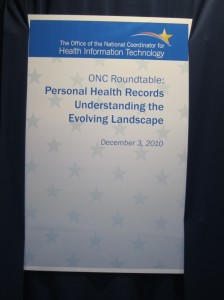Fact Sheet on Community Quality Collaboratives from AHRQ
Excerpted from Agency for Healthcare Research and Quality (AHRQ) on 12/12/2010
Community quality collaboratives are community-based organizations of multiple stakeholders, including health care providers, purchasers (employers, employer coalitions, Medicaid and others), health plans, and consumer advocacy organizations, that are working together to transform health care at the local level. The Agency for Healthcare Research and Quality offers these organizations many tools to assist in their efforts.
Background
Community quality collaboratives are key drivers of health care reform at the local level. These collaboratives, including 24 Chartered Value Exchanges, are implementing a bold vision for health care reform built on four cornerstones. are built on four cornerstones. These cornerstones are:
- Measuring and publishing quality information to enable consumers to make better decisions about their care.
- Measuring and publishing price information to give consumers information they need to make decisions on purchasing health care.
- Promoting quality and efficiency of care.
- Adopting interoperable health information technology.
AHRQ offers a compendium of tools and resources for other community quality collaboratives who want to follow paths similar to Community Leaders and Chartered Value Exchanges.
Tools for Collaborative Leadership and Sustainability
Sustainability Toolkit for Community Quality Collaboratives: An Overview of the Art & Science of Building Staying Power
Tools to help collaboratives build, maintain, and refine an infrastructure that supports and advances the mission of the organization as market and stakeholder expectations change
Go to: http://www.ahrq.gov/qual/value/suscqcollab.htm (PDF File, 150 KB; PDF Help)
Multi-stakeholder Community Inventory Modules
Tools to assess strengths and goals of Community Quality Collaboratives along 8 areas: collaborative leadership, public at-large engagement, quality and efficiency measurement, public reporting, provider incentives, consumer incentives, strategy for improving quality, health information technology/health information exchange.
Go to: http://www.ahrq.gov/qual/value/cimodules.htm (PDF File, 407 KB; PDF Help)
Regional Coalition Collaboration Guide
Assists community leaders in creating and sustaining a regional coalition based on lessons and tips from six pilot quality initiatives
Go to: http://www.ahrq.gov/qual/value/collabguide.htm
Tools to Engage Consumers
The Community Quality Collaborative Leader’s Guide to Engaging Consumer Advocates
Guide for including consumer advocates in Community Quality Collaboratives
Go to: http://www.ahrq.gov/qual/value/caguide.htm (PDF File, 175 KB; PDF Help)
AHRQ Publications for Consumers
Easy-to-understand publications for health care consumers
Go to: http://www.ahrq.gov/consumer/
Tools on Measures, Data, and Reports on Quality and Efficiency
Selecting Quality and Resource Use Measures: A Decision Guide for Community Quality Collaboratives
Tool to help community-based organizations striving to improve the quality of health care in their communities select quality of care and resource use measures.
Go to: http://www.ahrq.gov/qual/perfmeasguide/index.html (PDF File, 777 KB; PDF Help)
Consumer Assessment of Healthcare Providers and Systems (CAHPS®)
Public-private initiative to develop standardized surveys of patients’ experiences with ambulatory and facility-level care
Go to: https://www.cahps.ahrq.gov/default.asp
HCUPnet
Online query system that provides access to health statistics and information on hospital inpatient utilization and quality—at the national and state levels—and thereby can inform local quality agenda…
Go to: http://hcupnet.ahrq.gov/
National Healthcare Quality Report and National Healthcare Disparities Report
Annual, comprehensive overviews of the state of quality and disparities in health care in the United States
Go to: http://www.ahrq.gov/qual/qrdr09.htm
AHRQ Preventable Hospitalization Costs, a County-Level Mapping Tool
Downloadable software that can be used with administrative data on hospital admissions to assess the number and cost of “preventable admissions” in State or communities.
Go to: http://www.qualityindicators.ahrq.gov/mappingtool.htm
Identifying, Categorizing, and Evaluating Health Care Efficiency Measures
Rand report that identifies, analyzes, and classifies current definitions of efficiency, lays out a roadmap to help illuminate discussions, and identifies next steps.
Go to: http://www.ahrq.gov/qual/efficiency/index.html
AHRQ Quality Indicators
Downloadable software that can be used with hospital administrative data to assess quality of care. Software includes four modules: inpatient quality indicators; patient safety quality indicators; prevention quality indicators; and pediatric quality indicators.
Go to: http://www.qualityindicators.ahrq.gov/
Tools for Public Reporting
Best Practices in Public Reporting
The purpose of the Best Practices in Public Reporting series is to provide practical approaches to designing public reports that make health care performance information clear, meaningful, and usable by consumers.
Go to:
- How To Effectively Present Health Care Performance Data To Consumers
http://www.ahrq.gov/qual/pubrptguide1.htm - Maximizing Consumer Understanding of Public Comparative Quality Reports: Effective Use of Explanatory Information
http://www.ahrq.gov/qual/pubrptguide2.htm - How to Maximize Public Awareness and Use of Comparative Quality Reports Through Effective Promotion and Dissemination Strategies
http://www.ahrq.gov/qual/pubrptguide3.htm
Health Care Report Card Compendium
Searchable directory of over 200 sample report cards that show formats and approaches for providing comparative information on the quality of health plans, hospitals, medical groups, individual physicians, nursing homes, and other providers of care.
Go to: https://www.talkingquality.ahrq.gov/compendium/
Model Public Report Elements: A Sampler
An illustrative menu of public report elements from health care provider performance reports from around the country.
Go to: http://www.ahrq.gov/qual/value/pubrptsampler.htm
Quality Indicators Draft Model Reports
Model reports designed to report comparative information on hospital performance based on the AHRQ Quality Indicators
Go to: http://www.qualityindicators.ahrq.gov/downloads.htm#DraftModelReports
Talking to Consumers about Health Care Quality
Site designed for people and organizations trying to educate consumers about health care quality
Go to: https://www.talkingquality.ahrq.gov/
Tools on Incentives for Quality
Pay for Performance: A Decision Guide for Purchasers
An evidence summary organized around 20 questions that span four phases of purchaser decisionmaking: contemplation, design, implementation, and evaluation.
Go to: http://www.ahrq.gov/qual/p4pguide.htm
Decision Guide on Consumer Financial Incentives
An evidence summary organized around 21 questions that span incentive design and implementation decisions identified by user-stakeholders. It reviews the application of incentives to five types of consumer decisions: selecting a high value provider, selecting a high value health plan, deciding among treatment options, reducing health risks by seeking preventive care, and reducing health risks by decreasing or eliminating high-risk behavior.
Go to: http://www.ahrq.gov/qual/value/incentives.htm
Tools to Improve Preventive Services
U.S. Preventive Services Task Force
Expert recommendations for clinical preventive services
Go to: http://www.ahrq.gov/clinic/uspstfix.htm
A Purchaser’s Guide to Clinical Preventive Services: Moving Science into Coverage
Information source for employers on clinical preventive service benefit design
http://www.businessgrouphealth.org/benefitstopics/topics/purchasers/index.cfm 
Current as of September 2010


